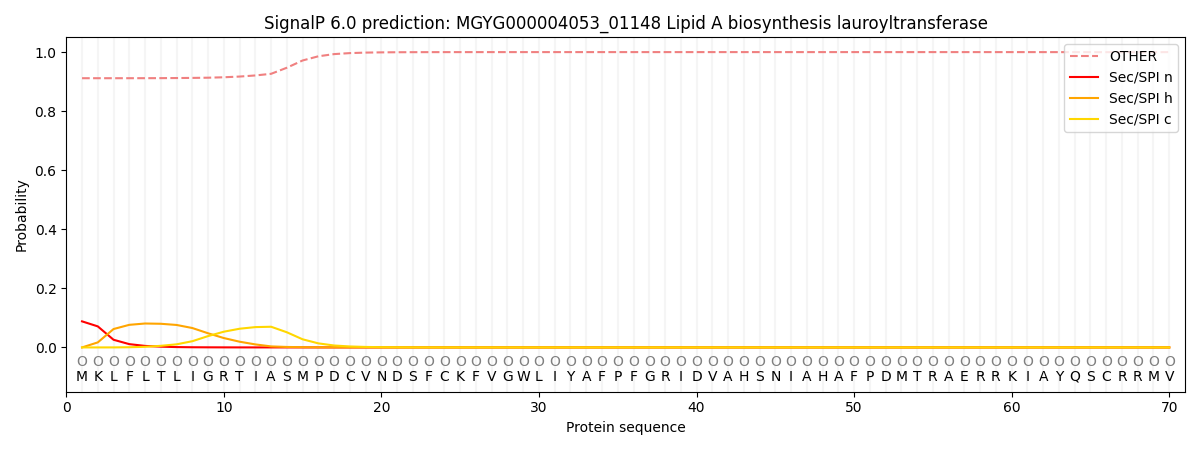You are browsing environment: HUMAN GUT
CAZyme Information: MGYG000004053_01148
You are here: Home > Sequence: MGYG000004053_01148
Basic Information |
Genomic context |
Full Sequence |
Enzyme annotations |
CAZy signature domains |
CDD domains |
CAZyme hits |
PDB hits |
Swiss-Prot hits |
SignalP and Lipop annotations |
TMHMM annotations
Basic Information help
| Species | ||||||||||||
|---|---|---|---|---|---|---|---|---|---|---|---|---|
| Lineage | Bacteria; Verrucomicrobiota; Verrucomicrobiae; Opitutales; CAG-312; CAG-312; | |||||||||||
| CAZyme ID | MGYG000004053_01148 | |||||||||||
| CAZy Family | GT9 | |||||||||||
| CAZyme Description | Lipid A biosynthesis lauroyltransferase | |||||||||||
| CAZyme Property |
|
|||||||||||
| Genome Property |
|
|||||||||||
| Gene Location | Start: 15924; End: 17828 Strand: + | |||||||||||
CAZyme Signature Domains help
| Family | Start | End | Evalue | family coverage |
|---|---|---|---|---|
| GT9 | 386 | 589 | 4.8e-23 | 0.8311111111111111 |
CDD Domains download full data without filtering help
| Cdd ID | Domain | E-Value | qStart | qEnd | sStart | sEnd | Domain Description |
|---|---|---|---|---|---|---|---|
| COG1560 | HtrB | 2.34e-32 | 4 | 280 | 20 | 296 | Lauroyl/myristoyl acyltransferase [Lipid transport and metabolism]. |
| cd07984 | LPLAT_LABLAT-like | 1.15e-26 | 88 | 280 | 1 | 191 | Lysophospholipid Acyltransferases (LPLATs) of Glycerophospholipid Biosynthesis: LABLAT-like. Lysophospholipid acyltransferase (LPLAT) superfamily member: acyltransferases of de novo and remodeling pathways of glycerophospholipid biosynthesis which catalyze the incorporation of an acyl group from either acylCoAs or acyl-acyl carrier proteins (acylACPs) into acceptors such as glycerol 3-phosphate, dihydroxyacetone phosphate or lyso-phosphatidic acid. Included in this subgroup are such LPLATs as lipid A biosynthesis lauroyl/myristoyl (LABLAT, HtrB) acyltransferases and similar proteins. |
| cd03789 | GT9_LPS_heptosyltransferase | 9.60e-25 | 316 | 604 | 1 | 247 | lipopolysaccharide heptosyltransferase and similar proteins. Lipopolysaccharide heptosyltransferase (2.4.99.B6) is involved in the biosynthesis of lipooligosaccharide (LOS). Lipopolysaccharide (LPS) is a major component of the outer membrane of gram-negative bacteria. LPS heptosyltransferase transfers heptose molecules from ADP-heptose to 3-deoxy-D-manno-octulosonic acid (KDO), a part of the inner core component of LPS. This family also contains lipopolysaccharide 1,2-N-acetylglucosaminetransferase EC 2.4.1.56 and belongs to the GT-B structural superfamily of glycoslytransferases, which have characteristic N- and C-terminal domains each containing a typical Rossmann fold. The two domains have high structural homology despite minimal sequence homology. The large cleft that separates the two domains includes the catalytic center and permits a high degree of flexibility. |
| pfam03279 | Lip_A_acyltrans | 6.99e-23 | 8 | 281 | 21 | 293 | Bacterial lipid A biosynthesis acyltransferase. |
| COG0859 | RfaF | 1.47e-20 | 316 | 631 | 3 | 334 | ADP-heptose:LPS heptosyltransferase [Cell wall/membrane/envelope biogenesis]. |
CAZyme Hits help
| Hit ID | E-Value | Query Start | Query End | Hit Start | Hit End |
|---|---|---|---|---|---|
| QYY35688.1 | 1.05e-111 | 5 | 608 | 6 | 620 |
| ATC65288.1 | 1.83e-107 | 1 | 613 | 2 | 621 |
| QYM80399.1 | 2.27e-93 | 1 | 623 | 2 | 625 |
| AWT60417.1 | 2.93e-90 | 1 | 608 | 1 | 614 |
| QXD27453.1 | 1.55e-88 | 1 | 632 | 1 | 649 |
Swiss-Prot Hits help
SignalP and Lipop Annotations help
This protein is predicted as OTHER

| Other | SP_Sec_SPI | LIPO_Sec_SPII | TAT_Tat_SPI | TATLIP_Sec_SPII | PILIN_Sec_SPIII |
|---|---|---|---|---|---|
| 0.918059 | 0.081520 | 0.000219 | 0.000082 | 0.000050 | 0.000080 |
